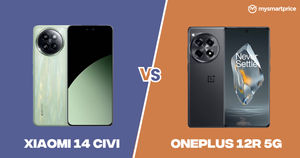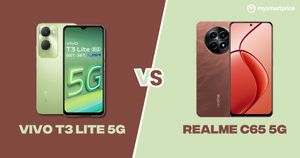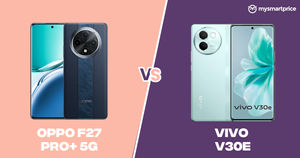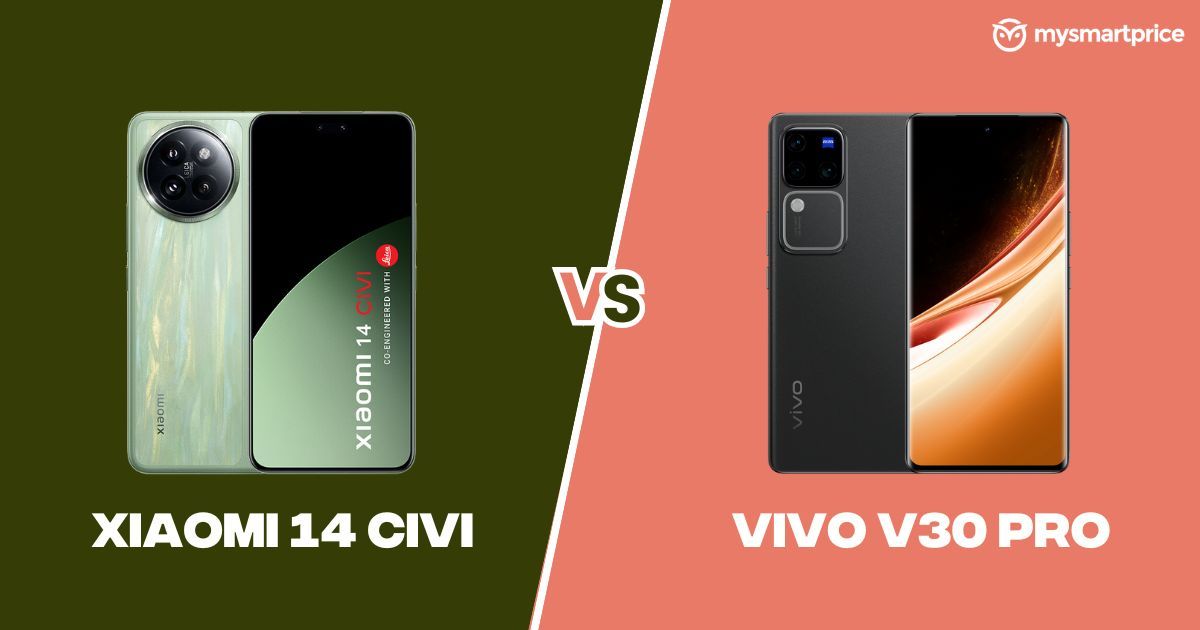
Last week, Xiaomi launched the Xiaomi 14 CIVI smartphone in the Indian market. The Xiaomi 14 CIVI is a camera-centric smartphone and the company’s most affordable option with Leica-tuned cameras. It directly competes against the Vivo V30 Pro, which comes with Zeiss optics and is considered one of the best camera smartphones in the segment.
In this post, let us compare the specifications of the Xiaomi 14 CIVI and the Vivo V30 Pro.
Xiaomi 14 CIVI vs Vivo V30 Pro: Specs at Glance
|
4.2 ★
|
4.5 ★
| |
|
₹ 42,999
|
₹ 41,999
| |
| Processor | Snapdragon 8s Gen 3 | MediaTek Dimensity 8200 |
| Display | 6.55″ (16.64 cm) 120Hz Display | 6.78″ (17.22 cm) 120Hz Display |
| Rear Camera | 50+12+50 MP Rear | 50+50+50 MP Rear |
| Front Camera | 32+32 MP Front | 50 MP Front |
| RAM & Storage | 8 GB RAM 256 GB Storage | 8 GB RAM 256 GB Storage |
| Battery | 4700 mAh 67W Charging | 5000 mAh 80W Charging |
| OS | Android v14 | Android v14 |
Xiaomi 14 CIVI vs Vivo V30 Pro: Price in India
| 8GB + 256GB | 12GB + 512GB | Availability | |
| Xiaomi 14 CIVI | Rs 42,999 | Rs 47,999 | Flipkart, Mi.com |
| Vivo V30 Pro | Rs 41,999 | Rs 46,999 | Flipkart, Vivo eStore |
The Xiaomi 14 CIVI is Rs 1,000 costlier across variants than the Vivo V30 Pro. It is available for pre-order and will go on sale in the country starting June 20.
Xiaomi 14 CIVI vs Vivo V30 Pro: Design
- The Xiaomi 14 CIVI has a metal frame and features a starry camera ring design. It weighs ~180 grams and is around 7.75mm thick. The handset has three colour options: Matcha Green, Cruise Blue, and Shadow Black. The Matcha Green variant of the device offers a unique lustre parquet pattern, achieved using 64% bio-based material. It has a nano vegan leather-textured rear panel. The phone has an IP53 rating for dust and water resistance.
- The Vivo V30 Pro features a fluorite AG glass design with rippling magnetic particles and a polycarbonate chassis. It is IP54 rated, making it dust and water-resistant. It weighs 188 grams and is around 7.45mm thick. It comes in two colour options: Andaman Blue and Classic Black.
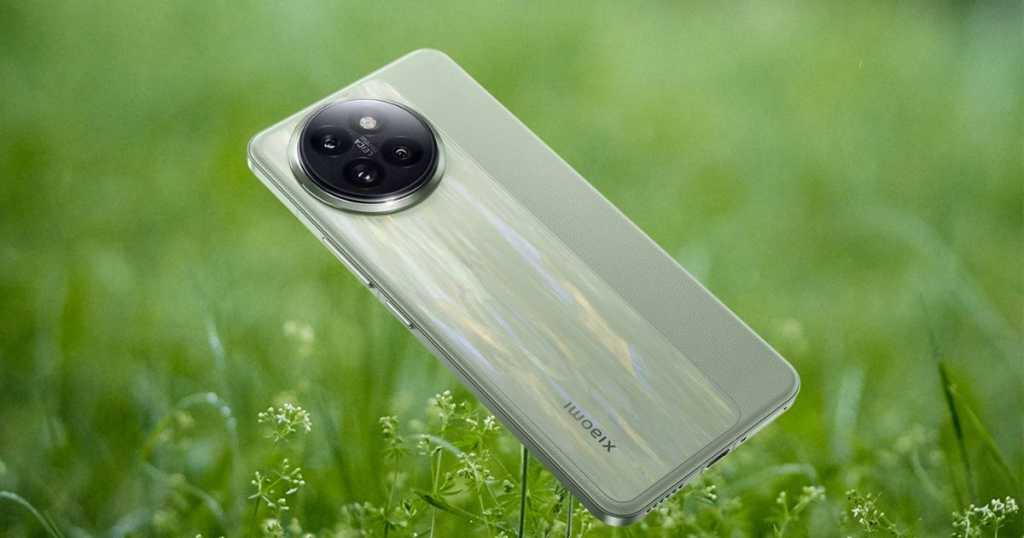
The Xiaomi 14 CIVI has a metal frame, which makes it stronger than the Vivo V30 Pro. On the other hand, the Vivo V30 Pro has a slightly higher IP54 rating than Xiaomi. Both smartphones have attractive designs, and one can pick either depending on one’s design taste and preference.
Xiaomi 14 CIVI vs Vivo V30 Pro: Display
- The Xiaomi 14 CIVI offers a 6.55-inch Quad Curved AMOLED display with a 1.5K resolution, 120Hz refresh rate, 3000nits peak brightness, 2160Hz PWM dimming, and Corning Gorilla Glass Victus 2 protection.
- The Vivo V30 Pro flaunts a 6.78-inch Curved AMOLED display with a 1.5K resolution, 120Hz refresh rate, 1200nits brightness, 2800nits peak brightness, and 2160Hz PWM dimming.
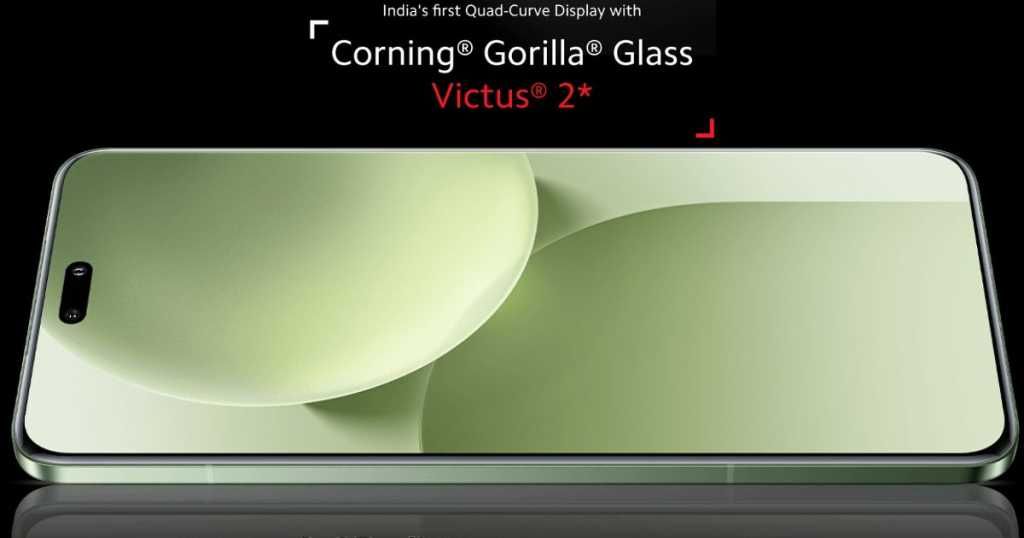
The Xiaomi 14 CIVI has a quad micro curved display with Corning Gorilla Glass Victus 2 protection, giving it an edge over Vivo’s.
Xiaomi 14 CIVI vs Vivo V30 Pro: Performance
- The Xiaomi 14 CIVI is powered by a Qualcomm Snapdragon 8s Gen 3 processor with an integrated Adreno 735 GPU. It offers up to 12GB LPDDR5X RAM and 512GB UFS 4.0 storage. The company has also equipped the device with an Iceloop cooling system.
- The Vivo V30 Pro sports a MediaTek Dimensity 8200 processor and an integrated Mali G610 GPU. It has up to 512GB UFS 3.1 storage and up to 12GB LPDDR5X RAM.
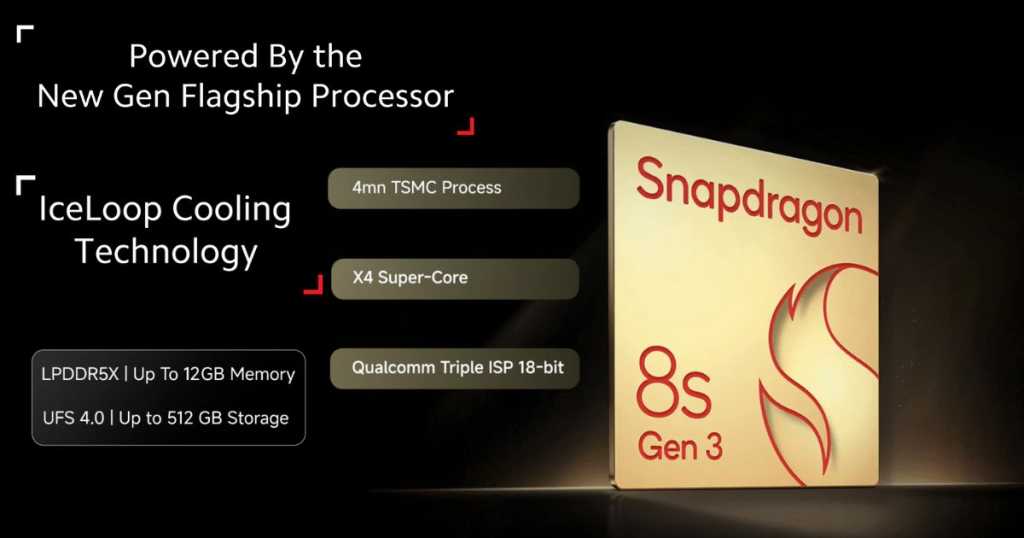
The Qualcomm Snapdragon 8s Gen 3 offers better performance when compared with the MediaTek Dimensity 8200. Also, the Xiaomi 14 CIVI features faster UFS 4.0 storage and an Iceloop cooling system, which gives it a clear advantage over the Vivo V30 Pro. Take a look at the synthetic benchmark score comparison.
Xiaomi 14 CIVI vs Vivo V30 Pro: Software
- The Xiaomi 14 CIVI boots HyperOS, which is based on Android 14. The smartphone is eligible for three Android version upgrades and four years of security patch updates.
- The Vivo V30 Pro comes with FunTouchOS 14, based on Android 14. The company has promised three years of software support, including two Android OS upgrades.
The Xiaomi 14 CIVI will receive updates until the Android 17 version. However, the last Android OS update for the Vivo V30 Pro will be Android 16. This gives the Xiaomi 14 CIVI an advantage over the Vivo V30 Pro.
Xiaomi 14 CIVI vs Vivo V30 Pro: Cameras
| Xiaomi 14 CIVI | Vivo V30 Pro | |
| Camera Partnership | LEICA | ZEISS |
| Primary Camera | 50MP Summilux Hunter 800 sensor with 25mm focal length, an f/1.6 aperture, and OIS |
50MP Sony IMX920 sensor with an f/1.88 aperture and OIS
|
| Telephoto Camera | 50MP portrait telephoto camera with 2x zoom, 50mm focal length, and an f/1.98 aperture |
50MP Sony IMX816 portrait camera with 2x zoom, 50mm focal length, and an f/1.85 aperture
|
| Ultra-wide Camera | 12MP Ultra-wide camera with 15mm focal length, 120° field of view, and an f/2.2 aperture |
50MP Ultra-wide-angle lens with 119° field of view and an f/2.0 aperture
|
| Front Camera | 32MP Autofocus camera with 2x portrait, 26mm focal length, and f/2.0 aperture |
50MP Autofocus camera with an f/2.0 aperture
|
| Secondary Front Camera |
32MP Ultra-wide Camera with 18mm focal length, 100° field of view, and an f/2.2 aperture
|
NA |
Xiaomi claims that the Xiaomi 14 CIVI can produce cinematic content and offers professional-grade optics. The handset offers a 25mm wide portrait mode, a 35mm documentary mode, a 50mm classic portrait mode, and a 90mm soft bokeh portrait. It features LEICA Authentic and LEICA Vibrant modes. All five Xiaomi 14 CIVI cameras can record 4K videos.

The Vivo V30 Pro is claimed to offer a professional portrait camera. It offers ZEISS Biotar style bokeh, ZEISS Planar style bokeh, ZEISS Distagon style bokeh, ZEISS Sonnar style bokeh, ZEISS Cinematic style bokeh, and ZEISS Cine-flare Portrait. It features Aura Light flash and supports Aura Light portrait video as well.
The Xiaomi 14 CIVI and Vivo V30 Pro are camera-centric smartphones with impressive hardware.
Xiaomi 14 CIVI vs Vivo V30 Pro: Battery and Charging
- The Xiaomi 14 CIVI has a 4,700mAh battery and 67W fast charging support.
- The Vivo V30 Pro has a 5,000mAh battery with 80W FlashCharge fast charging support.
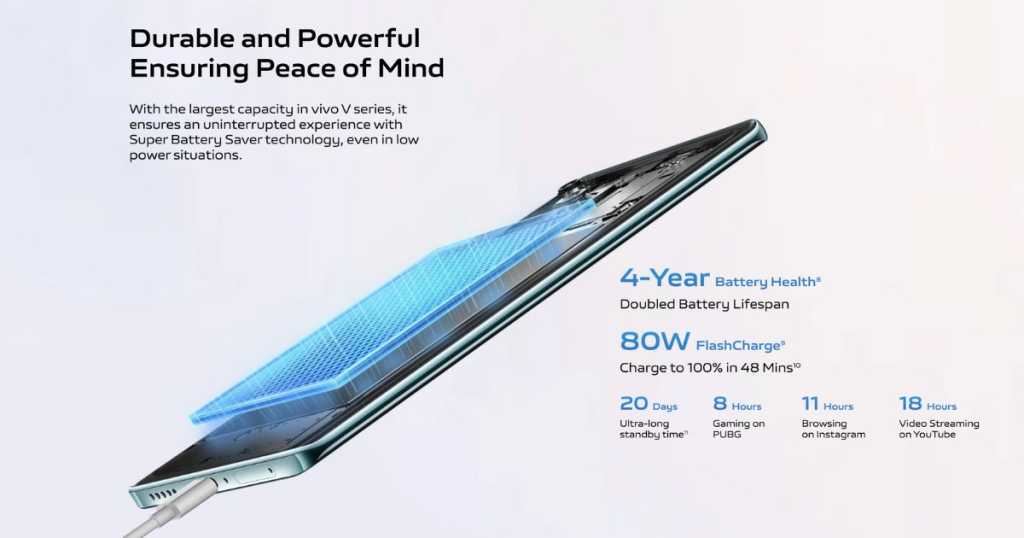
The Vivo V30 Pro has a slightly (about 6%) bigger battery and supports faster charging than the Xiaomi 14 CIVI, which gives it an advantage over Xiaomi’s offering.
Xiaomi 14 CIVI vs Vivo V30 Pro: Other Features
- The Xiaomi 14 CIVI has a stereo speaker setup with Dolby Atmos audio. It comes with Hi-Res audio and Hi-Res Wireless audio certifications. The handset also offers an infrared remote blaster and an in-display fingerprint scanner.
- The Vivo V30 Pro features a mono speaker and has an in-display fingerprint sensor.
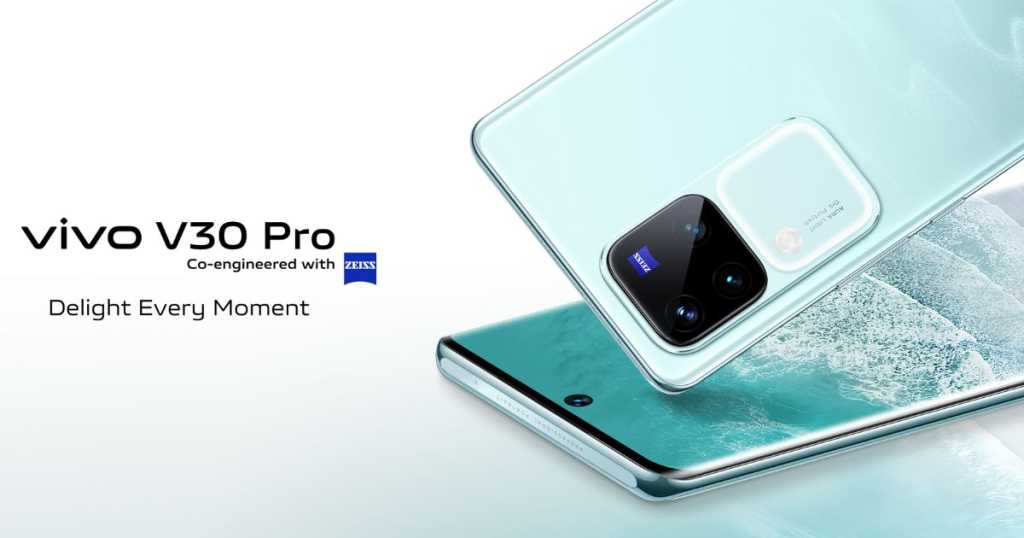
The Vivo V30 Pro’s lack of a stereo speaker setup is a bummer, as manufacturers have started including stereo speakers even in the Rs 15,000 price segment.
Xiaomi 14 CIVI vs Vivo V30 Pro: Verdict
The Xiaomi 14 CIVI features a metal chassis and a Corning Gorilla Glass Victus 2 display. It also has a faster processor and storage and will receive software support longer than the Vivo V30 Pro. The handset also has an ultra-wide selfie camera, which might be useful in certain scenarios.
The Vivo V30 Pro, on the other hand, offers a bigger battery and faster charging speed. It has a curved display, which some might prefer for the design.






